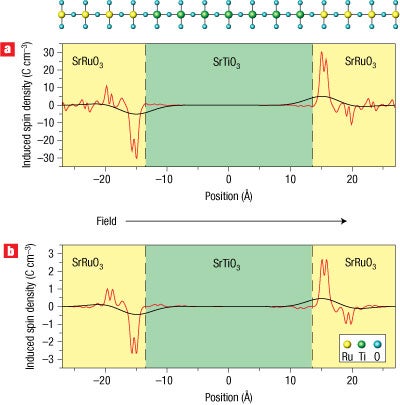UCSB Group
UCSB Group
Participants
Nicola Spaldin [Co-PI]
J. M. Rondinelli [PhD]
Activities
The UCSB group focused on the first-principles density functional calculations of the multiferroic properties of oxide heterostructures. In particular, the behavior of the interface between a ferromagnetic metal and a ferroelectric or dielectric in the presence of an electric field was investigated. These studies were extended to determine the magnetoelectric response of such heterostructures, with the goal of designing improved electric-field controllable magnets. SrRuO3/SrTiO3 was used as the model structure. Our work in this area was published in Nature Nanotechnology, and accompanied by an Editorial describing the contributions that advanced computational methods now make to nanoscience and nanotechnology. Our use of SrRuO3 as a model led us to some detailed studies of correlations in this material, which has traditionally been regarded as weakly correlated.
Dr. Spaldin has given the following invited talks on NIRT-related work:
- “Exploiting oxide interfaces to generate new functionalites,” TMS meeting, New Orleans, LA, 2008.
- “Progress and prospects in magnetoelectrics and multiferroics,” Indo-Japan Workshop on New directions in ferroics and multiferroics, Kolkata, India, 2008.
- “New routes to electric-field control of magnetism,” Materials Colloquium, UC Santa Barbara, 2008.
- “New routes to electric-field control of magnetism,” ISIS Colloquium, UC Irvine, 2008.
- “Progress and prospects in multiferroics and magnetoelectrics,” Angstrom Laboratory, Uppsala University, Sweden, 2007.
- “Multiferroics and magnetoelectrics,” Jawaharlal Nehru Center for Advanced Scientific Research, India, 2007.
- “Design of new magnetoelectrics and multiferroics,” CNSI seminar, UCLA, 2007.
- “Progress and prospects in multiferroics and magnetoelectrics,” Zernike Institute Colloquium, U. Groningen, Netherlands, 2007.
- “Grand challenges in oxides research,” The National Academies, Irvine, CA, 2007.
- “Progress and prospects in multiferroics,”Northwestern University, Materials Colloquium, 2007.
- “Progress and prospects in multiferroics,” International Conference on Electroceramics, Arusha, Tanzania (Plenary), 2007.
- “Multiferroics and mangetoelectrics,” Pan American Advanced Study Institute on Electronic States and Excitations on Nanostructures, Zacatecas, Mexico, 2007.
- “Alternative mechanisms for the magnetoelectric effect,” International Symposium on Correlated Electron Systems, Akihabara, Japan, 2007.
- “First principles calculations for metal-ferroelectric interfaces,”International Symposium on Integrated Ferroelectrics, Bordeaux, France, 2007.
- “Computational design of contra-indicated multifunctional materials,” University of Bonn, Physics Colloquium, 2007
Major Findings
Using first-principles density functional calculations, we demonstrated an entirely new carrier-mediated mechanism for magnetoelectricity in SrRuO3/SrTiO3 heterostructures. The magnetoelectricity is common to the interface between any ferromagnetic metal and dielectric, and is linear and fully electric-field switchable. We introduced and defined the concept of spin capacitance, which allows the formal quantification of the response of a magnetoelectric heterostructure to an applied electric field. We found that SrRuO3 seems to have signatures of strong correlations, and our preliminary calculations suggest that it is surprisingly very close to being half-metallic.
Image

A voltage of 27.8 mV was applied in a nanocapacitor consisting of seven layers of SrTiO3 alternating with seven layers of ferromagnetic, metallic SrRuO3 electrodes with parallel magnetic alignment. The static response including ionic and electronic contributions (a) and the high-frequency (electronic only) response (b) are shown. Note the factor of 10 difference in the y-axes. The red and black lines show the planar averaged and macroscopically averaged induced magnetizations, respectively.
From Rondinelli et al, Nature Nanotechnology 3:46 (2008). Permission requested AAAS.
Publications
Recent Publications
- James M. Rondinelli, Massimiliano Stengel, and Nicola A. Spaldin, “Carrier-mediated magnetoelectricity in complex oxide heterostructures,” Nature Nanotechnology 3, 46 (2008). [View article]